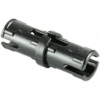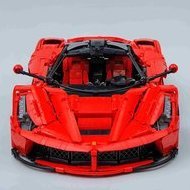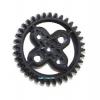Search the Community
Showing results for tags 'Power functions'.
Found 368 results
-
Hello everybody and let me present my version of a modified 42005 Monster Truck. It was my second set after my "dark age", that I've bought many years ago, after 42029 as supplementary set with a lot of useful pieces and planned to use for a live axle suspension and some other features for 42029 model. However, I liked the set as a simple and functional model and re-assembled it several times. Here is the model and later I'll provide the all details: A month ago, when I tired of infinite attempts to turn 41999 into a Muscle Car (the chassis isn't rigid enough, but I already did a great progress and hopefully will share it once) I returned to this model and set the task to motorize it adding 4WD, but keeping 4 wheels steering and current suspension (keep the original construction as possible as I can). First, I've analyzed the all existing attempts that I could find over EB, Rebrickable and YouTube and it happens that there were several MODs by different authors: First of all, it's @Splat’s MOD with all steered and driven axles (see topic here). I see no reason to duplicate its description, so let me just note that he saved the necessary features with adding Servo + L-Motor mounted under the hood and trunk. The chassis configuration is 4x4/4 or 4WD-4WS. It’s the best motorized model, I think, because of amazing simplicity and performance, but unfortunately it has a kind of “articulated” steering that isn't real, so was trying to made a "real" 4WD-4WS version, using this model as reference. Another one is Jan Dvorak’s (is he on EB?) MOD with all original features supplemented by on-axle L-Motor that drives the rear wheels and Servo for the 4WS. He added an additional 5X7 frame with differential that provided a necessary rigidness. The chassis configuration is 4x2/4 or RWD-4WS. Personally I don't like such a long axle sub-frame. However I've found a good idea of vertical gears inside the central shaft. The third one is @codefox421's MOD, inspired by Splat’s version, with the original front axle and non-steered custom rear axle with on-axle L-Motor. His custom rear axle, based on two portal hubs, is a quite compact and simple, but has no steering. The chassis configuration is 4x2/2 or RWD-FWS. It looks trial-ready with the portal hubs, but it's nearly impossible to add the steering here, so I got nothing from this model. An unusual @Tommy Styrvoky's MOD with an interesting feature: he modified the front axle, not the rear one, by adding a solid drivetrain with worm gear and on-axle M-Motor, so result is a front-wheels driven Monster Truck with oversized fake engine. The chassis configuration is 4x2/4 or FWD-4WS. Very aggressive! WRRRRR Daniel Wirasantosa’s (is he on EB?) MOD that differs from the previous ones by using of chassis-mounted L-Motor that drives the rear axle (that has a bit low ground clearance due to the 5x7 frame) and, moreover, he used a custom steering shaft that comes directly to the steering rack. The chassis configuration is 4x2/2 or RWD-FWS. Starting this version, I got a more or less defined plan: 4WD with off-axle (chassis-mounted) L-Motor that drives the both axles through the existing “drivetrain” (former steering shaft) and the off-axle Servo that steers the both axles through the custom steering shaft above the driveshaft. There were two more versions: Michael M’s stretched one and LEGOTechnic360’s solid-chassis version with no suspension, but they didn't help me with any new ideas. Nothing personal, guys, if you're reading it, I just had a full and consistent vision of my further MOD: Hull - the original with no changes. Axles geometry - original. I tried to save the all things like the wheels location, suspension mounting points, ground clearance, steering angles (that are even bigger a bit now)… And I still can't believe that made it, after a thousand tries! Suspension - original, with no changes. However I put the hard shock absorbers in the rear end, as the default ones were too weak to keep the BuWizz battery. Wheels - original. I decided to keep the original wheels and tires with no giant crawler ones or even Claas, that are too big even for a Monster Truck. Frame - mostly original, but possibly modified since it will have an L-Motor and Servo mounted above the axles (right under the cargo platform and hood). Drivetrain - it must be the ex-steering shaft that comes through the cardans inside the "big" ball joints to the both axles, connected to the L-Motor via the set of normal and clutch gears. Steering - for the all wheels, like in the original model, but the steering shaft comes above the drive shaft, in parallel with it and can slide a bit while the suspension moves. Enough the words...The most interesting part starts here. Following my plan, the bigger challenge was to modify the original axles - I tried several options, even trial-like with solid axles, but 4WS provides an amazing maneuverability due to big steering angles, so axle diffs are likely vital for such model (solid axles were making a permanent clicking noise in the transmission even with motor stalling sometimes) and I decided to make a fast Monster truck, not a slow crawler with a high torque. The drive train. There you can see how I did it: L-Motor rotates a set of 8T and 16T normal and clutch (required for the steering shaft) gears and then the main horizontal shaft, that were used for steering in the original model. After that the shaft rotates the 12T double bevel gears (ex-pinon gears from the original model), than 20T gears below, single-bevel 20T and the differentials. As result, the gearing ratio is 1:1.667 X 1:1.4 = 1.2334, and provides about ~100 RPM with 15.12 N.cm torque. The wheels connected by a wheel hubs, since I wasn't able to use the universal and CV joints with affordable steering angles, wheels position (I kept exactly the same position as in 42005) and rigidness. The steering. Here you can see the servo (mounted upside down in order to provide more space for the battery block above, steering shaft that goes above the driveshaft, 12T gears (pinions) and 13L racks joined to the wheel hubs. In order to allow the suspension travel, the gears has 1/2L offset from the racks and slides together with the shafts along the mounting points when the suspension compresses. It's a fully legal, but still allowed in LDD and works like a charm! The only mistake that the hubs must be from Claas, but they aren't presented in LDD unfortunately: Just to explain why I used the clutch gears (but with no gearbox actually, ha-ha ), the drive and steering systems intersects so hard, so followed TLG way and used the same solution that they did in the official models (42029, for example) - passed the one through the other. Green is a drive subsystem, blue - steering. The Axles. Here you can see how the steering shaft slides by 0.5L (notice the gap between the 12T black gear and LBG liftarm) - it provides about 1L suspension travel for the both axles. Other images, the story of a modified hull (by Phil), LDD file and instruction in PDF are coming soon...
- 3 replies
-
- pf
- power functions
-
(and 8 more)
Tagged with:
-
Greetings, Train Tech! Here's a model of the BR24 steam locomotive from Germany, built at my usual 15 inches / stud scale: The BR24 (or "DRG Class 24") were a standard class of German locomotives built in the 1920s and 1930s. As was the case with most standard German designs, plans were drawn up and orders were placed from various manufacturers. They served through World War 2, and continued to serve into the 70s in West Germany, East Germany, and in Poland (as the Oi2 class) Most photos of the locomotives show them fitted with the larger Wagner smoke deflectors (the "elephant ears") -- I've chosen to model the locomotive with the smaller Witte deflectors, which were fitted on a few examples later in their life. I was motivated to build this locomotive for two reasons. First, I wanted a suitable locomotive to go with the Umbauwagen I had built. Secondly, I hadn't seen many new takes on this model since Ben Beneke's version from the early 2000s! There are many builders who have modified Ben's design, often substituting BBB medium wheels for the rare large wheels from the set 7750. However, my typical scale is larger than the scale of Ben's model, and I also wanted to leverage some new parts that have come out since. Like most of my locomotives, this model features Power Functions. A single M-motor beneath the cab powers the drivers at a 5:3 reduction ratio. The locomotive is fairly light but pulls adequately, and there's room in the boiler for additional weight if needed. In a way, this model helps to understand and demonstrate how little weight and torque you can get away with; I see a lot of builders cram extra motors into their locomotive, when the torque can't be transmitted due to a lack of weight. The tender houses the Power Functions receiver and battery box. The 3-axle tender has a rigid frame, with the center axle sliding to negotiate curves (I used a similar geometry on the TP56 locomotive). The body of the tender lifts off for access. The battery box is mounted sideways to better take advantage of the shape of the tender. Coupled together, the locomotive has decent reception from all angles except the front, where the cab blocks the receiver. Incidentally, my model of the 2MT, which exhibited similar reception characteristics, happened to fall off the table during prototyping of this model. About 60% of the 2MT's parts wound up in the BR24, which is actually a pretty good recycling rate! I took the model to Bricks By The Bay 2017, where it spent many hours pulling the Umbauwagen around BayLUG's display. It also won "Best Machine" in the "Scale Models" category: Thanks to anyone who came by to see it, and the rest of the display! Here's the full Brickshelf gallery, along with some Work-In-Progress pictures. I've also brought you some footage of the locomotive in action: Thank you for reading! EDIT: I finally made instructions! https://rebrickable.com/mocs/MOC-106527/NonsenseWars/148-br24-drg-class-24-power-functions-powered-up/ ---------------------------------------------------------------------------------------------------------------------------------------------------------------------------- One final note: Ben was one of the builders who had been active around the time I first started buidling Lego train MOCs -- so in a way, this model is an homage to him. A few of the design techniques used in this model are based on techniques in his models -- the hinges angling the sides of the cab, the 11-plate-diameter boiler, and the way the smoke deflectors are attached. If you're still out there in the hobby, Ben, thank you for inspiring me and a whole generation of builders.
- 20 replies
-
- interiors are overrated
- moc
- (and 6 more)
-

[Epic Fail] Small Ring Crane
Saberwing40k posted a topic in LEGO Technic, Mindstorms, Model Team and Scale Modeling
Good grief, this thing has been sitting on my desk for over a year now, and I just now got around to taking pictures of it. tsk tsk. Anyway, this is a failed attempt at making a ring crane using a hailfire droid wheel as a base. It is loosely based upon a Sarens SGC-120, and uses a 3 way reversable distribution gearbox, much like 42042. Each selector controls one function, forward and reverse. The crane features 3 winches, controlling the boom luffing, the luffing jib, and the hook. The winches are run by one M motor. The counterweight is 5 PF AA battery boxes, plus some old train weights, and some ball bearings. Now, I mentioned that this is a failed attempt, and there are a good number of reasons for that. Firstly, the gearbox connecting the M motor to the distribution box was very weak and overly complex. Then, this model had several critical structural flaws. The main boom wasn't nearly stiff enough, and would warp with the slighted provocation. The individual sections were strong enough, but the connections to get them in a triangular shape were not. Then, the main frame of the crane was very weak, and bent a lot under the weight of the main boom. Same thing goes for the rollers on the base ring. They were not structurally sound at all, and due to that, motorized slewing was not possible. Lastly, the hook was not heavy enough to put tension on the hook line, and so the lines of rope going to the hook would jump at the slightest provocation. Still, even if this did fail, it looked impressive, and I learned from it. IMG_20170813_202442189 by Saberwing007, on Flickr The crane, in all of its glory. Ring Crane 002 by Saberwing007, on Flickr The gearbox. Each selector controls a winch. Ring Crane 003 by Saberwing007, on Flickr The M motor. This was one of the weak points of the model. Not the motor, but the gearbox it is attached to. Ring Crane 004 by Saberwing007, on Flickr The rollers. Not stable enough. Ring Crane 005 by Saberwing007, on Flickr The counterweights. There were two more battery boxes, but they got used for something else. IMG_20170813_202804340 by Saberwing007, on Flickr The crane base, without the booms or counterweight. Ring Crane 007 by Saberwing007, on Flickr The winches. Ring Crane 008 by Saberwing007, on Flickr The frame bending. IMG_20170813_210407144 by Saberwing007, on Flickr The gearbox extracted. Ring Crane 010 by Saberwing007, on Flickr The underside of the gearbox. It's dead simple, aside from the connection to the M motor, which was more complex than it needed to be, and would fail with minimal provocation. Well, that's it. There will be no video, as this got demolished for my TC12 entry. Enjoy, as much as you can enjoy a train wreck like this.- 7 replies
-
- ring crane
- fail
-
(and 2 more)
Tagged with:
-

[MOC] Big ferris wheel
veryrusty posted a topic in LEGO Technic, Mindstorms, Model Team and Scale Modeling
Everyone, Wanted to share a MOC I have built for our local lego expo, Canberra Brickexpo. It took me around 6 months (I'm a slow builder), and has more than 7000 pieces I wanted to build something big and I achieved it with the Ferris wheel. The look on the kids faces was amazing. It is structurally strong in the vertical direction, but move it to the horizontal and it comes apart in about 200 pieces. I found this out the hard way. This version is the 3rd version. Version 1 was too small. Version 2 was not strong enough, and broke it's stand. Version 3, with some tweaking worked for 8 hours straight. Ferris wheel by Russell Murphy, on Flickr -

[HELP] Propulsion by L Motor and XL Motor
T Lego posted a topic in LEGO Technic, Mindstorms, Model Team and Scale Modeling
Hi everyone, I am making a new lego technic supercar, but I have a question. For my propulsion system I want to use 2 XL and 2 L motors. Since the XL and L motor have different rpm (XL 110 and L 195), I don't know what the best way is to conect them. If I have done the Maths correct the L motor should be geared down by 1:1.77. I am trying to connect them in that gearratio but the best option I have found so far is to gear the L motor down by 1:1.66t (using the 20 tooth and 12 tooth gear). Other suggestions are welcome! When powering the motor the sound is just a little bit different, but I dont know if I am damaging the motors and getting all of the torque..... -
Hello eurobricks train tech!! I bring you today my first lego train moc. I am new to eurobricks so please point out any mistakes I may have made. I was inspired by scotnick's 14xx and decided to have a go at it. The construction of the model went very smoothly and I had originally used the 2x4 turntable for the trailing wheel. When I tested it, it wouldn't function properly and I had to replace it. So for two hours, I experimented with many different designs until I came up with one utilizing the ring plate and that err...longish blueish pin thingy! But it fit the bill and I'm happy! It is powered by the lego train motor with lights for the Lantern and the receiver in the cab. I do plan to build a autocoach to go with it which will house the battery box. Another problem I encountered was I had none of the I think 4x4 round bricks with holes in dark green, and since I don't buy any parts, I just used the 4x6 long half circle brick (I'm not that great with piece names!) And used some double sided tape to stick on the domes and an ausini clone brand chain for the chain on the front (I'm unarmed don't shoot! ) So stay posted guys, and look out for more projects coming soon! Comments and tips are very much welcome.
- 1 reply
-
- train
- locomotive
-
(and 5 more)
Tagged with:
-
Updating the first post to have all three RC mods in one place. 1st version - Power Functions motors & SBrick control This is a quick and dirty upgrade, it started as a test to see if 2 or 4 L motors can drive the set properly, but things escalated quickly :) The aim was to add the PF components without taking apart the set completely or to change original structure, so obviously there are more elegant ways to hide all the motors and to upgrade the suspension and the drive train. The list of the added elements: 4 PF L motors (drive) 1 PF Servo motor (steering) 3 PF M motors (functions) 1 PF switch 2 8878 Battery boxes 4 PF lights 2 SBricks The 4 L motors can drive the car, but it has no extraordinary performance due to the added weight. The servo motor is struggling sometimes (especially when the car is not moving), it'd need another servo motor or some other solution for the steering to work smoothly. 2nd version - pickup-style body, 4 buggy motors, 2 BuWizz units After the first attempt I wanted to build something faster, so I had to reduce weight and add more power :) The back part of the truck was removed, I removed also a lot of non vital elements (like the fake V8). 4 Buggy motors were added and they were powered by 2 BuWizz units. The results was pretty fast considering the tracks and could handle the obstacles well. 3rd version - tracks removed, wheels added, pickup-style body, 4 buggy motors, 2 BuWizz units This is my third and last Lego 42069 Extreme Adventure remote control mod. After the previous version I did not plan to create another one but I was convinced by some comments on my YouTube channel (thanks for the tip!). Although I really liked 42069 on tracks, I realized that the top speed was limited by the construction so the 4 buggy motors could not show their full potential. I removed the tracks and added the wheels from the 9398 Crawler set. The pickup-style body was kept from the previous mod to ensure the car is as light as possible. The axles were rebuilt completely to fit the buggy motors and the wheels. The car is driven by 4 buggy motors and there's a PF Servo for steering. It is controlled and powered by 2 BuWizz units. It became surprisingly fast, I was curious so I added a small GPS tracker to measure the top speed - you can check the result in the video :)
- 36 replies
-
- sbrick
- power functions
-
(and 2 more)
Tagged with:
-

Tiny tracked vehicle with amazing power functions
Leonard Goldstein posted a topic in LEGO Technic, Mindstorms, Model Team and Scale Modeling
Hi everybody, my first topic, my first moc ... With this moc a had two goals building a tracked vehicle: 1. Make it as small as possible 2. Maximize playability with lots of power functions To the first point: the distance between the tracks is only six studs and the whole vehicle fits into the shovel of a 42030 And now the power functions: it is using a 8878 rechargeable battery box, an SBrick and four M-motors. Two motors are used for driving and there is a subtractor inside (which means one motor runs the vehicle forward/backward, the second motor is turning it left/right). The third motor runs the container lifting device at the back and it also locks/unlocks the trailer coupling. As it is double worm geared it is very slow, but very strong. The last motor runs the lifting device at the front. As there was absolutely no space left for any more gearing, it works by using a rope and a set of pulleys. Enough words, here some more pictures: As you can see these are pictures made with the LDD and so it was easy to extract the power functions: All just digital? Of course I know what you are waiting for. And here is the video showing this little thing in action: http://dai.ly/x5tmoni If you like my creation and want to copy it you can find a LDD-File here: http://bricksafe.com/pages/Leonard_Goldstein/tiny-tracked-vehicle There is also a background picture availably for your SBrick-profile (as you can see in the video). Maybe you have to adjust the resolution depending on your mobile device. Some notes to the LDD-file if you want to copy this: 42003 on the roof are not placed exactly as this is an illegal lego connection. Watch the video for exact position. Same for 32039 at the rear axle. The lifting device at the front needs a rubber band to keep the rope tight. Otherwise the rope would fall of the pulleys. For the lifting device I used a beam with ball cup which is not available in the LDD. I replaced it by 6M Half beams and a 2M cross axle. The cable routing is quite tricky as the vehicle is so small. I used same cable fixer to make this easier. Ok, no Lego-parts. Shame on me. But you can get them in every do-it-yourself store for a little money. Greetings Leonard Goldstein- 9 replies
-
- tracked vehicle
- rc
-
(and 2 more)
Tagged with:
-
hi all, I have just started into the world of Lego trains and controlling them with Arduino and i'm afraid it's become somewhat of an obsession! I have always loved Lego and trains since I was a child but could never afford it. I have a son who's 6 and shares my love of trains so I figured now was a good time to start! :-D I have limited amount of Lego at the moment, and have been mucking around in LDD and Stud.io building some signals, etc..this also includes using Arduino to control lights as well as trains..my first try with using some IR transmitter LEDs worked, but not real well which made me wonder whether IR is really the best method of control..I have read alot of comments already from people that RF is really the way to go so I will try that next when the 433Mhz Tx and Rx pair arrive. This led me to think of the next weakest link in the chain..the battery, which only lasts so long and is a pain to have to pull out and change..I know Lego and even third party companies have a rechargeable battery, but I'm buggered if I'm gonna pay $100-120 for each one!!! I've never had any 9v or 12v rail-powered Lego, and the way I understand it, you switch on the control, it powers the rail so much and makes the train go...but what if the rail was powered on all the time and you still controlled the train with an internal controller (like the RF receiver). Any thoughts on this? Sorry if I sound like a noob, since I have no experience with how the track-powered system works. sPy from Oz.
- 4 replies
-
- remote control
- trains
-
(and 3 more)
Tagged with:
-
.thumb.gif.ad7c8d88b264ee812194946c07404504.gif)
[MOC] 2WD Drift Racer Chassis
mocbuild101 posted a topic in LEGO Technic, Mindstorms, Model Team and Scale Modeling
This was originally designed to be the smallest RC car to use a buggy motor, but it soon became an extremely powerful car capable of drifting. I refined the chassis design over 2 prototypes, and then tried multiple combinations of gear ratios and different sizes of wheels to achieve the best speed. The result: this MOC you are looking at right now! Driven by buggy motor, geared 1:1.25 Steered by PF servo Hidden power switch on underside LDcad/POV-Ray animation Video: http://bricksafe.com/files/mocbuild101/drift-racer-chassis/video.mpg Instructions: http://www.rebrickable.com/mocs/MOC-8835/mocbuild101/2wd-drift-racer-chassis 3D File http://www.bricksafe.com/files/mocbuild101/drift-racer-chassis/2WD Drift Racer 3D file.mpd- 30 replies
-
- instructions
- video
-
(and 6 more)
Tagged with:
-
Hi everyone, Several years ago I got one set of the famous Horizon Express. But 2013 was a period I came into a small dark age. Most of my Lego City sets were sold off, including the train itself. Now after several years I´m slowly coming out of the dark age. I am planning to make a new city somewhere in the future, but currently I lack the space for any Lego creations. So most of those have to be stored in a box under my bed. My starting point for a new city was a large modular styled train station. As you can see here it's still under construction so minifigs can't enjoy it yet. New Canalview city station WIP Ofcourse I also wanted to have a nice train running around in this new city. I have bought the City high speed passenger train, but felt it was a little too simplistic to go with the new modular styled train station. Another option was creating my own passenger train. But that would take a lot of time, and I'm not really a train builder. Then I remembered the gorgeous Horizon Express that I used to have. I started up my computer and went searching for a second hand copy. It turned out the aftermarket was even more expensive then the original set! Two sets would cost me around € 400,- which is way too much for me. Also two sets would be really long, even too long for the new train station. But after that I wasn't going to give up, I browsed almost all Lego catalogues for more inspiration for the new train. Then I came across an old 12 V set which I really liked as a kid because of it's colors and attention to detail. And then it struck me, why not combine the Horizon Express with the color of the older 12V set? After researching for parts on BrickLink it turned out that a red/black version of the horizon express could be build! After scrambling my own parts for it and calculating it turned out the be much cheaper than buying two new Horizon express's. The result can be seen here: More high res pictures here: https://www.flickr.com/photos/145979506@N07/ There are some changes to the original, like the shape of the lights, the number of cars and the windows of the passenger cars. I like it kinda better this way. It still needs an interior, but I'm happy with the result for now. Also, I'm planning to add real lights to it so it can drive at night too. Hope you like it as much as I do! If you have any suggestions or comments please let me know!
- 13 replies
-
- power functions
- train
- (and 5 more)
-

Something with Broken Parts and Customer Service
MattL600 posted a topic in LEGO Technic, Mindstorms, Model Team and Scale Modeling
I have 2 broken m motors and 1 broken servo motor, I'm going to throw the servo motor out cause it's not useless and I can mod the m motors (maybe). I also have a battery box with a broken leg hole. Anyways I decided to do this because I've been trying to contact Lego but they keep sending me an error message and blocking me from reaching the humans... Please help, PS I have tons of other broken technic parts but not as important as this.- 29 replies
-
- lego customer support
- broken
-
(and 1 more)
Tagged with:
-

[MOC]1977 Holden Torana SLR 5000
veryrusty posted a topic in LEGO Technic, Mindstorms, Model Team and Scale Modeling
Here's the last of my three MOCs. This one is a 1977 Holden Torana. It was created to take on the big Falcon's in Australian touring cars, by putting a large 5 litre V8, in what was a comparatively small sedan. It was a great idea, but executed too quickly. The V8 was only tested on a dyno, but when put in a racecar, the high cornering speeds caused oil surges and creating reliability issues. These were fixed in the followup XU1, which became dominant. That didn't stop Holden fans from buying the SLR5000 in droves. My SLR5000 features: - Full independent suspension. - Remote control driven by 2 L motors servo and sbrick. - V8 motor - 4 opening doors, bonnet and boot. IMG_20170528_140254 by Russell Murphy, on Flickr IMG_20170528_140309 by Russell Murphy, on Flickr IMG_20170528_140406 by Russell Murphy, on Flickr- 1 reply
-
- suspension
- aussie
-
(and 1 more)
Tagged with:
-

Lamborghini Gallardo
legotechnicisawesome posted a topic in LEGO Technic, Mindstorms, Model Team and Scale Modeling
hi eurobricks! i started this topic a bit late i know, but i still havent finished yet! here is a photo of my progress so far: i need some ideas for the the dash and centre console as a car is not a good car with out a good interior! here is my progress on the inside: any help with the dash and console would be greatly appreciated! thanks!- 32 replies
-

Modular trial truck chassis idea
Zerobricks posted a topic in LEGO Technic, Mindstorms, Model Team and Scale Modeling
I got this idea a while ago, when I first got Sbricks. Why not make modular, expendable system of axles and chassis pieces in order to create a system for offroad truck construction. Here is what I sketched up in LDD. First we have a basic axle. It uses 2 XL motors for drive, independet suspension and steering with servo Because we need a minimum of 2 axles, I designed a double chassis holder with two battery boxes: If we combine 2 axles with the double battery holder, we get the most basic configuration, a 4x4x4: In order to expand on the system I designed a single battery chassis extension: Finally we can combine the three basic modules into a 6x6x6: Or even a 10x10x10: In theory there is no limit how far you can go, but I think anything over 12x12 might cause too much strain on the chassis. Important details: - Axles are designed for Claas wheels, which are not in LDD, hence the wheels above may look small - Each axle can use any kind of a combiantion of number of springs and hardnesses for best flexibility and weight support - Each axle is meant to also house and S brick, which allows you fine steering angle control in order to support any kind of configuration or steering mode (only front, only rear, all wheel steering, crab mode) - For now this is still a concept, so I will relase the LDD file once I build, test and polish the concept- 6 replies
-
- modular
- trial truck
-
(and 9 more)
Tagged with:
-

Power functions lights and 42039 question
teos posted a topic in LEGO Technic, Mindstorms, Model Team and Scale Modeling
I've been modifying my 42039 (24 hrs racecar) to be remote controlled with an sbrick and was wondering if the power functions light unit will work for that set? I don't have any of them, so I'm not sure if the wires are long enough to reach both light sections in the front (or two sets of PF lights one front and back). Thanks in advance! P.S. I just got my 1st sbrick last week and they are amazing. Now I want another. -

[MOC]Bulldozer
legosamigos posted a topic in LEGO Technic, Mindstorms, Model Team and Scale Modeling
Hello Eurobrickers! Today I would like to show you my new MOC - a bulldozer. This is not a specific bulldozer model, although I watched little a Caterpillar D9T. A blade and a ripper are full remote controlled, does it mean, can be raised, lowered and tilting. Dimensions: -length: 43 cm, -width: 26 cm, -height: 20 cm, -weight: 1738 grams. Power Functions: drive and steering – 2 PF L motors, blade can be raised, lowered and tilting by 2 PF M motors, ripper can be raised, lowered and tilting by 2 PF M motors, 1 x PF extension wire 20 cm, 1 x PF small battery box, 3 x PF IR receiver, 3 x PF IR remote control. Some pictures, rest are available at the public galleries Brickshelf gallery Bricksafe gallery Youtube video -

[AMS1] 42056 Porsche 911 GT3 RS Crawler 4x4
Zerobricks posted a topic in LEGO Technic, Mindstorms, Model Team and Scale Modeling
I decided to open a seperate topic for this beast. Inspired by Letsbuild's idea to crawlify a Lego set, i decided to go full crazy and try to upgrade the biggest, heaviest and most orange set to date, Porsche 911 GT3 RS. First thing I built was the front axle, which uses the H frame as a placeholder for bewel gear, so there it no possible way of them to slip: Those with sharp eyes may notice the gears are not aligned, this was done in LDD development mode, more info soon The drive than goes directly to portal hubs with 1:3 gear ratio, giving the model 1:5 gear ratio on each wheel. Front axle also has a servo motor which steers the wheels and powers the Porsche's original steering wheel via a ball joint Rear axle powers the Porsche's gearbox via a couple of clutch gears in order to allow different motor speeds when steering or skid steering - Yes, this 4 kilogram heavy model can even skid steer thanks to its independent motor control. Here is the end result As with the original set, I kept the rear axle 2 studs wider than the front: For suspension I used 4 hard springs, which are hald compressed thanks to the model's immense weight. Due to the porsche's wide chassis springs are quite far apart, so the flex angle is not really big, but on the other hand that makes the model much more stable. Performance wise the crawler works very good, despite its massive weight, so far I had no broke U joints or gears and it has enough torque to skid its wheels on hard surface. Expect more pictures soon and a video soon. -

BMW S1000RR iPerformance Concept Bike
TheMindGarage posted a topic in LEGO Technic, Mindstorms, Model Team and Scale Modeling
This is my entry to the Rebrick BMW Motorrad competition. Its goal is to balance both performance and sustainability to show that high-performance vehicles have a future in a world concerned with emissions and fuel consumption. I used double wheels on both the front and rear in order to make this model driveable. The wheels are made from 36 chain links bent "the wrong way" - they are around 16cm (20 studs) in diameter. The whole model is about 55 studs long and 13 wide. The drivetrain consists of a PF Large motor geared 1:1 and a PF XL motor geared 5:3. They are hard coupled - yes, I know this is frowned upon but it provides a compact solution, and the load on the motors is no different to driving a car up a hill. The motors are mounted inside the rear wheels to save space and simplify the drivetrain. The motors are connected to an IR receiver which is mounted inside the main body. The battery pack is positioned at the very bottom to lower the center of gravity and increase stability. There is a shaft connecting a 4-cylinder piston engine to the wheels. This piston engine runs on E85 bioethanol which is derived from plants. This means it is renewable and carbon-neutral - the carbon dioxide released when burning it is compensated for by the plants used to make them photosynthesising. It also has a higher octane rating than gasoline, meaning it can actually provide better performance than the fuel it replaces. E85 biofuel engines already exist - all recent Koenigsegg vehicles are capable of running on both gasoline and E85, and these engines can produce up to 1 megawatt from a 5-litre V8. I believe biofuel is the future for high-performance vehicle manufacturers such as BMW. The front suspension uses a Duolever setup where the front fork is suspended on two parallel wishbones. The front wheel is able to move up and down and steer, while having the shock absorbers mounted on the wishbones rather than as part of the forks. A steering linkage allows a PF Medium motor to control the front wheel. The rear suspension uses a similar system called Paralever. It is essentially one half of a car independent suspension, complete with universal joints. It is sturdy and keeps the rear wheel's motion vertical when the suspension compresses. The front and rear wheel arches use the bucket wheel parts from 42055 as an internal structure. I used pneumatic hoses as part of the structure to give the flared appearance of the rear arch. greenshotcertificity.com Every part of the motorbike is designed with the BMW brand in mind (honest, it's nothing to do with the lack of turn signals ). The panelling (especially the side intake) is inspired by the BMW i8, a hybrid supercar by BMW. The suspension matches the types used on current BMW motorbikes, and inline-4 engines are commonly used on both their bikes and passenger cars. Here's a video showing the bike's drifting and burnout capabilities. Music is composed by me. Enjoy!- 2 replies
-
- bmw
- motorcycle
-
(and 6 more)
Tagged with:
-
I want to know where to buy the type of wire Lego uses in PF parts, I can only find grey IDC ribbon cable (see below). I need it to be black to replace some worn out wire on some of my PF parts. Has anyone ever found a matching type of wire/cable? Thanks .
-

Power Functions - combining different motor types
xXFoxhound90 posted a topic in LEGO Technic, Mindstorms, Model Team and Scale Modeling
Hi everyone, Two little question regarding Power Functions: 1. Is it possible to combine 2 L-motors with 2 XL-motors at the same time, working on the same gear of a car (2,0-2,5 kg) or will only motors of one type work? 2. How many M-, L- and XL-motors can be used on a single 8887 rechargable battery box (to move the same car as above) at the same time? Thank you in advance! xXFoxhound90 -
Thought the EB Technic community might appreciate this remake of the 2001 Bionicle set I built for a contest on another forum. It features the same RC tracked drive and swiping claws as the original (this time powered by Power Functions elements, rather than a giant RC brick) plus light-up eyes via PF lights. https://youtu.be/Q76HBzIxZ0E (Apologies if this belongs in the Action Figures subforum - I thought it was probably a better fit for the Technic forum?)
-
.thumb.gif.ad7c8d88b264ee812194946c07404504.gif)
[MOC] Automatic Motorized Compressor
mocbuild101 posted a topic in LEGO Technic, Mindstorms, Model Team and Scale Modeling
This MOC came about from my wanting of a super compact all-in-one Lego compressor, and after trying many different auto valve designs (and about a week of building), this is what I came up with: Video: Features: Air tank Automatic pressure switch M motor and 6L mini pump compressor Very compact 15 x 11 x 7 stud size Easy removal of battery box Pneumatic tube lengths: 1x 3L (2.4cm) 2x 10L (8cm) 1x 14L (11.2cm) All the pneumatic tube lengths listed above (and most of the other parts) are available in 8110-1 Unimog U400. Instructions are available on Rebrickable. The compressor uses a single 6L mini pneumatic pump, but can easily be modified for two pumps. The automatic cut-off pressure can easily be adjusted by changing the strength of the rubber bands attached to the pneumatic cylinder.- 20 replies
-

[GBW] - Supporting the war effort - Plantasea - The Power of the People
BoBKiD posted a topic in The Great Brick War
[GBW] Part 1: "The Power of the People" The Plantasea forces recruit men from all over the country in order to man all military units and reserves. The recent attack on Filace means only one thing: War is inevitable! [MOC] The Main Gate [GBW] by BoBKiD206, on Flickr The MOC: MOC] The Main Gate [GBW] by BoBKiD206, on Flickr MOC] The Main Gate [GBW] by BoBKiD206, on Flickr MOC] The Main Gate [GBW] by BoBKiD206, on Flickr MOC] The Main Gate [GBW] by BoBKiD206, on Flickr MOC] The Main Gate [GBW] by BoBKiD206, on Flickr As a small extra, the MOC features Power Function lighting. The following pic was taken in total darkness with just the power fuctions lights on. [MOC] The Main Gate [GBW] by BoBKiD206, on Flickr- 1 reply
-
- great brick war
- plantasea
-
(and 4 more)
Tagged with:
-
Im new to this forum so hi everyone ;) i have fun with PF from few months, and i want to buy a li-po and customize it to lego, i got two of real power hungry buggy motors, and i want to feed em' as much as i can :D I only need to know which voltage is maximum for motors, and for reciever, i have maken a research across internet, and ive heard that motors can handle max 16volts , and reciever just 9 volts, but ive heard too that motors can handle max 12 volts and that reciever too, on many forums i have read different numbers, so i have to ask here :) i have found light and small 14,8 volt li po 850 mah, in good price and i like it, but i dont want to burn my buggy motors and rest of PF, im wondering too about rc unit voltage, if it have 6 aa 1,5v bateries fully charged, it could generate 9v as normal pf battery box but when i compared them, rc unit is way better, and buggy motors are way faster, i hope that someone can help me :)
- 53 replies
-
- pf
- power functions
-
(and 7 more)
Tagged with:



.thumb.jpg.06400152156e5e95cce608e8f2153c26.jpg)


